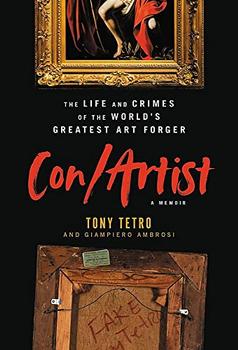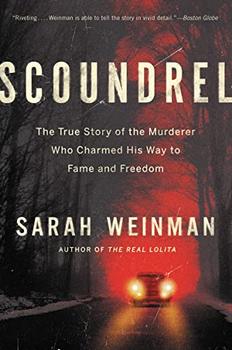Summary | Excerpt | Reviews | Beyond the book | Read-Alikes | Genres & Themes | Author Bio

The Life and Crimes of the World's Greatest Art Forger
by Tony Tetro, Giampiero AmbrosiAs a lover of both art and true crime media, art forgery stories are a goldmine for me. They have all the seediness of the criminal underworld, but centered around art. In my vision of the forgery world, the forgers are bookish anarchists, all the victims are snobs, and hardened FBI agents break down weeping over a Chagall. I'm not alone in those fantasies; novels like Daniel Silva's Portrait of an Unknown Woman prove people want to read art forgery served up with international intrigue. Con/Artist is not a book like that. Tony Tetro, the subject and one of the authors, has little in common with romanticized portrayals of his profession. The book is an easy read, full of interesting facts about forgeries, all centered around a pretty regular guy.
In an ironic twist, this book about forgery inspired some confusion over authorship for me. Both Tetro and journalist Giampiero Ambrosi are credited as authors, but it's not clear who wrote what. (Ambrosi is also a television producer working on a documentary about Tetro.) Either way, the writing is often unpolished. For instance, characters and anecdotes are introduced suddenly and not fully explained, and the reader is left puzzling over the meaning of vague words and phrases, like "completely bananas" ("Yamagata was a mild, placid guy, but I heard he scared the shit out of whoever was in the gallery that day. He went completely bananas; they had never seen anything like it"). It's impossible to know if Tetro's inexperience as a writer is to blame or if Ambrosi and/or editorial staff have rushed the book to come out with the documentary.
However, the simple language does make Con/Artist more readable. If you're in the mood for an art-related book you can read on a plane, this would be a good choice. Tetro's unremarkable backstory sucks the reader in, as one might wonder how he became a skilled forger. Raised in Fulton, NY, Tetro enjoyed painting as a hobby growing up. As an adult, he worked as a milkman, sold cheap furniture, and invested $200 in a stock he heard about at the pool hall. When the stock's price eventually doubled, he used the funds to move to California, but had no luck finding a job there. He got the idea to forge art in a hilariously unglamorous way: he bought a book about art forgery at the grocery store.
As an artist myself, I liked reading about how Tetro developed the styles and palettes of the artists he forged. "If you wanted to do an early Picasso, you used house paint, and if you wanted to paint like Dalí, you put the paint on so thin you could see the texture of the canvas underneath," Tetro writes. Caravaggio is his favorite, and there's a moving scene where an artist he meets in Italy teaches him the painter's style. "To achieve Caravaggio's convincing flesh tones, the old man would lightly lay down a base of lead white, then mix other tones of white combined with vermilion, sienna, ochre, or umber, building up different layers to create his pale skin and the shapes and contours of his shoulders, ribs, and chest," he recalls.
The first thing I learned about forgery is the importance of establishing provenance. Perhaps even more important than the art is the route it took to get into a seller's hands. For this reason, Tetro writes, it's best not to replicate known paintings. Instead, he did research in the library looking for mentions of lost paintings. Without the original, Tetro simply had to match the painter's style and materials, then create a backstory and forge documentation.
Despite all the care taken, Tetro asserts that he could never do this work now. Since the height of his career in the 1980s, technology has improved so much that appraisers can study paintings on a molecular level. Additionally, tools are available to dissect colors, revealing their age and the place they came from. It's hard to believe Tetro did all of his research before the internet, but that same tool would likely have exposed him much earlier.
Throughout the book, it's clear that Tetro has a sense of integrity about his creations. He loves the challenges and the process of getting all the details right. I understood his commitment to seeing projects through and making adjustments to improve the work. Despite understanding the pride Tetro takes in his work, though, I wouldn't say we had much in common. I don't care about cars like he does, I hate cigarette smoke, and I've certainly never been popular at parties in Costa Rica. Yet, his story really affected me, particularly when he recounts getting busted. We usually want to see the criminal caught and brought to justice. It's harder when the criminal is a nonviolent man painting at home. Though I expected the downfall, I hadn't considered the collateral damage. I saw how quickly Tetro's friends and associates disappeared and how many clients had betrayed him along the way, refusing to pay the thousand they owed him.
Con/Artist demystified the world of forgery for me, and showed me a reality that compelled while it repulsed. The thought of secretly making a convincing Picasso with period methods and tools is totally seductive. I'd love to watch people in a museum marvel at something I made, thinking it was an original masterpiece. But would I want that at the cost of secrecy and exploitative friends? Though his work was an imitation, Tetro is still a real person. In the end, the romanticized view of art forgery is the biggest fake of all.
![]() This review
first ran in the January 18, 2023
issue of BookBrowse Recommends.
This review
first ran in the January 18, 2023
issue of BookBrowse Recommends.

If you liked Con/Artist, try these:

by Dean Jobb
Published 2026
In this captivating Jazz Age true crime about "the greatest jewel thief who ever lived" (Life Magazine), Arthur Barry, who charmed celebrities and millionaires while simultaneously planning and executing the most audacious and lucrative heists of the 1920s.

by Sarah Weinman
Published 2023
From the author of The Real Lolita and editor of Unspeakable Acts, the astonishing story of a murderer who conned the people around him - including conservative thinker William F. Buckley - into helping set him free
Your guide toexceptional books
BookBrowse seeks out and recommends the best in contemporary fiction and nonfiction—books that not only engage and entertain but also deepen our understanding of ourselves and the world around us.